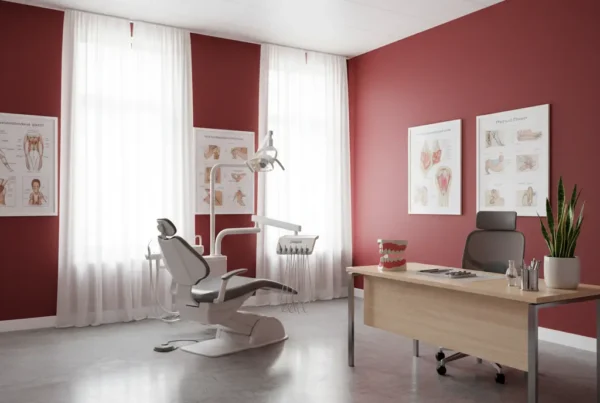Managing TMJ pain effectively requires understanding that this isn’t just a simple jaw problem, but a condition that affects your whole daily life and needs a comprehensive approach to get better. TMJ pain can make it hard to eat, talk, or even sleep comfortably, but the good news is that there are many different ways to manage and reduce this pain for long-term relief. Think of TMJ pain management like building a strong house, you need a solid foundation of healthy habits, strong walls of proper exercises, and a protective roof of medical treatments when needed.
Dr. Bethaney Brenner in Burlington, Connecticut has over 40 years of experience helping patients find lasting relief from TMJ pain through comprehensive treatment approaches. As a graduate of the University of Connecticut School of Dental Medicine with specialized certification in DTR therapy for treating facial pain and jaw dysfunction, she understands that effective TMJ management requires addressing lifestyle factors, muscle problems, and sometimes medical interventions. Her recognition as one of America’s Best Dentists and her holistic health background allow her to help patients understand how different aspects of their lives affect their jaw pain.
The key to successful TMJ pain management is understanding that small changes in your daily habits can make a big difference in how your jaw feels, while specific exercises can strengthen and relax the right muscles to support your jaw joint properly. Dr. Brenner’s teaching experience since 1980 and her role as Treasurer on the Connecticut State Dental Association Board of Governors help her stay current with the latest research on TMJ treatment approaches that provide lasting relief rather than just temporary fixes.
Understanding What Causes Your TMJ Pain
Learning about the different things that can cause TMJ pain helps you understand why your jaw hurts and what you can do to make it feel better. TMJ pain doesn’t usually have just one cause, instead it often comes from a combination of factors that affect how your jaw joint and muscles work together. Understanding these causes helps you and your healthcare provider develop the most effective treatment plan for your specific situation.
Structural problems with your jaw joint or bite alignment can create uneven pressure that leads to pain and dysfunction over time. When your teeth don’t fit together properly or your jaw joint isn’t aligned correctly, your jaw muscles have to work harder to do normal activities like chewing and speaking, which can cause fatigue and pain.
Muscle tension and imbalances around your jaw are another major cause of TMJ pain, often resulting from habits like teeth clenching, jaw clenching during stress, or grinding your teeth at night. These muscle problems can create a cycle where tight muscles cause pain, which causes more muscle tension, making the problem progressively worse if not addressed properly.
Stress and emotional factors play a significant role in TMJ pain because psychological stress often causes physical tension in your jaw muscles, leading to clenching and grinding behaviors that you might not even be aware of doing. Learning to recognize and manage stress can be just as important as treating the physical symptoms of TMJ.
Simple Lifestyle Changes That Make a Big Difference
Making smart changes to your daily habits and lifestyle can significantly reduce TMJ pain without requiring medications or medical procedures. These modifications work by reducing stress and strain on your jaw joint and muscles, giving them opportunity to heal and function more normally. The best part about lifestyle changes is that they’re under your control and can provide lasting benefits.
Stress management is one of the most important lifestyle changes because stress directly affects jaw clenching and teeth grinding, often without realizing you’re doing it. Learning relaxation techniques like deep breathing, meditation, or yoga helps you become more aware of jaw tension and consciously relax these muscles throughout the day.
Dietary modifications can give your jaw muscles and joint the rest they need to heal by choosing foods requiring less chewing effort. Cutting food into smaller pieces, choosing softer textures, and avoiding extremely chewy or hard foods makes eating more comfortable while reducing TMJ workload.
Improving posture, especially when working at computers or looking at phones, helps keep your head, neck, and jaw in proper alignment. Simple lifestyle changes that can reduce TMJ pain include:
- Practice stress reduction through relaxation techniques or enjoyable activities
- Choose softer foods and cut food into smaller, easier-to-chew pieces
- Maintain good posture with your head balanced over your shoulders
- Avoid habits like chewing gum, biting nails, or clenching your jaw
- Create a relaxing bedtime routine to reduce nighttime teeth grinding
Dr. Brenner’s holistic health training helps her understand how these lifestyle factors work together to affect TMJ symptoms and overall wellness. Implementing these changes gradually allows your body to adjust while building sustainable habits that support long-term jaw health.
Exercises and Physical Therapy for Your Jaw
Specific exercises designed for your jaw muscles can help reduce pain, improve movement, and strengthen the muscles that support your TMJ for better long-term function. Just like other parts of your body, your jaw muscles benefit from the right kind of exercise that stretches tight areas and strengthens weak areas to create better balance and stability. These exercises are usually gentle and can be done at home once you learn the proper techniques from a qualified healthcare provider.
Strengthening exercises help build endurance in the muscles that support your jaw joint, making them less likely to become fatigued and painful during normal daily activities. Simple exercises like gently opening and closing your mouth against light resistance can help build strength without overworking already sensitive muscles.
Stretching and mobility exercises help reduce muscle tension and improve the range of motion in your jaw joint, which can decrease stiffness and make eating and speaking more comfortable. These gentle movements help maintain flexibility and prevent muscles from becoming too tight and painful.
Physical therapy techniques like massage, heat therapy, and joint mobilization provided by trained therapists can address muscle tension and joint stiffness that you can’t effectively treat on your own. Professional treatment often provides faster and more complete relief than exercises alone. Working with a physical therapist ensures you receive proper instruction and can progress safely through more advanced techniques as your condition improves. The combination of professional therapy and consistent home exercises creates the most comprehensive approach to managing TMJ symptoms and preventing future flare-ups.
Medical Treatments When You Need Extra Help
When lifestyle changes and exercises aren’t enough to control your TMJ pain, medical treatments can provide additional relief and help address underlying problems that contribute to your symptoms. These treatments range from simple oral appliances to medications and more advanced procedures, depending on your specific needs and the severity of your TMJ disorder. The key is working with healthcare providers who understand TMJ to determine which treatments are most appropriate for your situation and can integrate with your overall health plan.
Custom-made oral appliances like night guards or bite splints can help protect your teeth from grinding damage while also reducing stress on your TMJ by keeping your jaw in a more comfortable position. These devices are typically worn at night when teeth grinding is most common, but some people benefit from wearing them during stressful daytime periods as well.
Medications can provide relief from TMJ pain and inflammation when used appropriately as part of a comprehensive treatment plan, ranging from over-the-counter anti-inflammatories for mild symptoms to prescription muscle relaxants for more severe muscle tension and spasms. Working with healthcare providers ensures that any medical treatments complement your other TMJ management strategies. The goal is always to use the least invasive approaches first while having more advanced options available when needed for optimal symptom control.

Knowing When to Seek Additional Help
Recognizing when your TMJ pain needs more intensive treatment helps ensure that you get appropriate care before the problem becomes more severe or chronic. While many people can manage their TMJ symptoms effectively with lifestyle changes and exercises, certain signs indicate that professional evaluation and treatment are needed to prevent long-term complications. Understanding these warning signs empowers you to seek timely intervention when self-care measures aren’t sufficient.
Persistent pain that doesn’t improve with conservative self-care measures after several weeks suggests that the underlying causes of your TMJ disorder may require professional diagnosis and treatment. When pain interferes significantly with eating, sleeping, or daily activities, it’s important to seek help rather than just trying to cope with the discomfort.
Worsening symptoms or new symptoms like jaw locking, significant limitation in mouth opening, or numbness and tingling around your jaw or face indicate that your TMJ problem may be progressing and needs prompt professional attention to prevent permanent damage. Early intervention often leads to better outcomes and can prevent the need for more invasive treatments later. Don’t hesitate to seek professional help when symptoms persist or worsen despite your best self-care efforts.
Building Your Support System
Successful TMJ pain management often involves working with healthcare providers who understand the complexity of TMJ disorders and can provide education, guidance, and treatment coordination to help you achieve the best possible outcomes. Dr. Brenner’s extensive training in facial pain treatment and her comprehensive approach ensure that patients receive thorough evaluation and coordinated care that addresses all aspects of their TMJ disorder. Building a strong support network creates the foundation for long-term symptom management and improved quality of life.
Patient education about TMJ helps you understand your condition, recognize triggers that worsen your symptoms, and learn effective self-management techniques that can prevent flare-ups and maintain improvement over time. Understanding how your daily habits and stress levels affect your TMJ empowers you to take an active role in managing your condition.
Clear communication with your healthcare team ensures that all aspects of your TMJ treatment work together effectively and that any concerns or changes in your symptoms are addressed promptly to maintain optimal results. The combination of professional expertise, patient education, and ongoing support creates the most effective environment for managing TMJ symptoms successfully. This collaborative approach helps ensure that you have the tools and resources needed to maintain improvement and prevent future problems.
Your Path to Long-Term Relief
Effective TMJ pain management is achievable through a personalized approach that combines the right lifestyle modifications, targeted exercises, and appropriate medical treatments based on your individual needs and symptoms. Understanding that TMJ pain often has multiple contributing factors helps explain why comprehensive treatment approaches tend to be more successful than focusing on just one aspect of the condition. Dr. Brenner’s 40+ years of experience, specialized training in DTR therapy, and holistic health background provide the expertise needed to develop effective, individualized treatment plans for lasting TMJ relief.
The foundation of successful TMJ management lies in making sustainable lifestyle changes that reduce stress on your jaw joint and muscles while learning exercises that promote proper muscle balance and joint function. When these conservative approaches are combined with appropriate medical treatments and ongoing professional guidance, most people can achieve significant improvement in their TMJ symptoms and quality of life.
With proper understanding, consistent self-care, and appropriate professional support when needed, TMJ pain can be effectively managed to allow you to return to normal eating, speaking, and sleeping without constant discomfort. Dr. Brenner’s comprehensive approach ensures that all aspects of your TMJ disorder are addressed for the most complete and lasting relief possible.
Book Your Consultation Today!
Dr. Bethaney B. Brenner DMD
8 Milford St, Burlington, CT 06013
Frequently Asked Questions
What are the best ways to manage TMJ pain at home?
The most effective at-home strategies include practicing stress reduction techniques like deep breathing and mindfulness, eating softer foods that require less chewing, maintaining good posture to reduce jaw strain, and doing gentle jaw exercises to strengthen and stretch the muscles around your TMJ as recommended by your healthcare provider.
Can physical therapy really help my TMJ pain?
Physical therapy can be very beneficial for TMJ pain because it addresses muscle tension, improves joint mobility, and teaches you exercises to strengthen and balance the muscles that support your jaw. Many people experience significant improvement in pain and function through targeted physical therapy approaches designed specifically for TMJ disorders.
When should I consider medical intervention for my TMJ pain?
You should consult with a healthcare provider experienced in TMJ treatment if your pain persists despite lifestyle changes and self-care measures, if your symptoms are worsening, or if TMJ pain is significantly interfering with eating, sleeping, or daily activities. Early professional intervention can often prevent more serious problems from developing.





